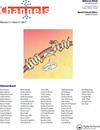Orai1 regulates calcium entry into dendritic spines
IF 3.2
3区 生物学
Q2 BIOCHEMISTRY & MOLECULAR BIOLOGY
引用次数: 3
Abstract
The possible role of store operated calcium entry (SOCE) through the Orai1 channel in central neurons has attracted growing attention in recent years because of its involvement in regulation of calcium homeostasis in the neuron. One unique neuronal compartment associated with calcium homeostasis is the dendritic spine, the site of excitatory synapses in the majority of neurons in the brain. It has been linked to neuronal plasticity, which is highly regulated by calcium influx during intense synaptic activity. The formation, plasticity and longevity of dendritic spines have been studied extensively, but the rules governing these processes are still not clear and not universal. The cultured hippocampal neuron provides a convenient vehicle to study the role of SOCE channels in dendritic spine formation and plasticity. Indeed, recent studies have detected the presence of Orai1 channels in central neurons, and further studies indicated that STIM2, the sensor for endoplasmic reticulum calcium store depletion, is instrumental in maintenance of mature dendritic spines in cultured hippocampal neurons. We have recently analyzed the role of Orai1 in dendritic spine formation and plasticity. This study follows our interest in the role of calcium stores in spine plasticity, where we found that dendritic spines contain ryanodine receptor-type calcium stores. In the more recent study, we employed plasmids that encode the Orai1 protein, as well as plasmids that encode the dominant negative (DN) Orai1. We also knocked down Orai1, using selective siRNA for this protein. In calcium store-depleted neurons a transient elevation of extracellular calcium concentration ([Ca2C]o) caused a rise in [Ca2C]i that was mediated by activation of the SOCE. The store depletion resulted in an increase in STIM2 association with Orai1 in dendritic spines. The response to the rise in [Ca2C]o was larger in spines endowed with a cluster of Orai1 molecules than in spines devoid of Orai1. Furthermore, topical application of calcium-containing medium, in a calcium-free extracellular environment, could trigger the formation of novel dendritic spines, and their location was highly correlated with the presence of Orai1 cluster (Fig. 1). Transfection of neurons with DN-Orai1 resulted in retarded maturation of dendritic spines, a reduction in synaptic connectivity with afferent neurons and a reduction in ability to undergo morphological changes following induction of chemical LTP. Likewise, siRNA-treated neurons had fewer mature dendritic spines, and lower rates of spontaneous mEPSCs compared to scrambled control siRNA-treated neurons. Thus, our results indicate that Orai1 channels are effective in causing a transient rise in [Ca2C]i in dendritic spines so as to facilitate maturation of dendritic spines and functional synapses in central neurons. It is hypothesized that in the absence of active synapses, either because presynaptic fibers still did not yet arrive, or are prevented from releasing neurotransmitters, the presence of Orai1 will serve to load a local rise of [Ca2C]I, sufficient for the dendrite to facilitate formation of protrusions, which upon interactions with a presynaptic-terminal, be converted to mature spines. Thus, Orai1 is assumed to be instrumental in formation of spines. It is still unclear which is the “partner molecule” that is linked to Orai1, and it could either be STIM1 (2) or STIM2 (3). Both of them are present in hippocampal neurons, in differentOrai1调节钙进入树突棘
近年来,通过中枢神经元中Orai1通道的储存操作钙进入(SOCE)可能参与神经元中钙稳态的调节,引起了越来越多的关注。树突棘是与钙稳态相关的一个独特的神经元隔室,它是大脑中大多数神经元兴奋性突触的所在地。它与神经元可塑性有关,而神经元可塑性是由突触剧烈活动时的钙流入高度调节的。树突棘的形成、可塑性和寿命已经得到了广泛的研究,但控制这些过程的规则仍然不清楚,也不是普遍的。培养海马神经元为研究SOCE通道在树突棘形成和可塑性中的作用提供了便利的载体。事实上,最近的研究已经在中枢神经元中发现了Orai1通道的存在,进一步的研究表明,内质网钙储存耗尽的传感器STIM2在培养海马神经元成熟树突棘的维持中起着重要作用。我们最近分析了Orai1在树突棘形成和可塑性中的作用。这项研究遵循了我们对钙储存在脊柱可塑性中的作用的兴趣,在那里我们发现树突棘含有ryanodine受体型钙储存。在最近的研究中,我们使用了编码Orai1蛋白的质粒,以及编码显性阴性(DN) Orai1的质粒。我们也用选择性siRNA敲除Orai1蛋白。在钙储存耗尽的神经元中,细胞外钙浓度([Ca2C]o)的短暂升高引起[Ca2C]i的升高,这是由SOCE的激活介导的。储存耗竭导致树突棘中STIM2与Orai1的关联增加。在具有Orai1分子簇的脊柱中,对[Ca2C]o升高的响应大于缺乏Orai1的脊柱。此外,局部应用含钙培养基,在无钙的细胞外环境中,可以触发新的树突棘的形成,它们的位置与Orai1簇的存在高度相关(图1)。用DN-Orai1转染神经元导致树突棘成熟迟缓,与传入神经元的突触连接减少,以及化学LTP诱导下发生形态变化的能力降低。同样,与混乱对照sirna处理的神经元相比,sirna处理的神经元具有更少的成熟树突棘,并且自发mEPSCs的比率更低。因此,我们的研究结果表明,Orai1通道可以有效地引起树突棘中[Ca2C]i的短暂升高,从而促进树突棘和中枢神经元功能突触的成熟。据推测,在缺乏活跃突触的情况下,要么是因为突触前纤维尚未到达,要么是因为被阻止释放神经递质,Orai1的存在将有助于加载局部升高的[Ca2C]I,这足以使树突促进突起的形成,突起与突触前末端相互作用后,转化为成熟的棘。因此,Orai1被认为是脊柱形成的工具。目前还不清楚哪个是与Orai1相关的“伴侣分子”,可能是STIM1(2)或STIM2(3)。它们都存在于海马神经元中,以不同的形式存在
本文章由计算机程序翻译,如有差异,请以英文原文为准。
求助全文
约1分钟内获得全文
求助全文
来源期刊

Channels
生物-生化与分子生物学
CiteScore
5.90
自引率
0.00%
发文量
21
审稿时长
6-12 weeks
期刊介绍:
Channels is an open access journal for all aspects of ion channel research. The journal publishes high quality papers that shed new light on ion channel and ion transporter/exchanger function, structure, biophysics, pharmacology, and regulation in health and disease.
Channels welcomes interdisciplinary approaches that address ion channel physiology in areas such as neuroscience, cardiovascular sciences, cancer research, endocrinology, and gastroenterology. Our aim is to foster communication among the ion channel and transporter communities and facilitate the advancement of the field.
 求助内容:
求助内容: 应助结果提醒方式:
应助结果提醒方式:


